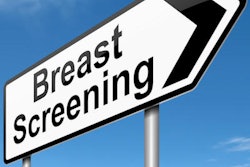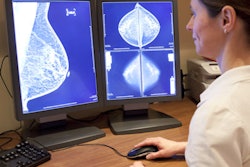
Recall rate for screening mammography is one of the key performance metrics for breast imagers, and reducing it can be one of the hardest things to do, according to research presented this week at the Society of Breast Imaging (SBI) conference in Austin, TX.
There are three simple interventions that can improve a department's recall rate -- and that means recall rates for individual radiologists as well, said presenter Dr. Babita Panigrahi of Johns Hopkins Hospital. With these steps, Panigrahi and colleagues found that recall rates decreased and there were also considerable cost savings.
"We saw our recall rates go way down," Panigrahi told AuntMinnie.com. "And at a cost of more than $1,000 on average per recall for further testing or biopsy, the savings are significant."
Simple actions
The researchers implemented the following three changes to their breast screening program starting in 2012, and continued with them through 2015.
Staff survey. The team first conducted a discussion with 10 breast imagers on the topic of recall rates and perceptions of their performance. "We gathered our breast imagers together and talked about their reasons for making recalls, from objective factors such as BI-RADS category to subjective reasons like fear of medical malpractice," she told AuntMinnie.com.
Data review. For the second action, the researchers asked breast imagers to review their personal recalls, record outcomes, and identify patterns that improved cancer detection and reduced false positives. They also asked imagers to review the group's overall recall rate. "This step was important because it gave the group both a sense of how it's performing overall and how individuals stand," she said.
Double reading. The third intervention consisted of consensus double reading of all recalls between two radiologists. Each breast imager collected 2D and 3D mammograms that they felt needed to be recalled and reviewed them with a colleague. "Two sets of eyes looking at these possible recalls can help imagers make an appropriate decision," she said.
How well did the program work? They assessed its success by first analyzing performance metrics during a baseline period before the changes were incorporated. This period included 52,637 2D mammograms and 5,597 3D mammograms.
They then analyzed the same metrics during the postintervention period, which included 8,452 2D mammograms and 8,695 3D mammograms. Panigrahi noted that the accepted standard for recall rates from screening mammography is 10% or less.
The interventions did indeed produce improvements, the group found.
| Mammography performance metrics, pre- and postintervention | ||
| Metric | Preintervention | Postintervention |
| 2D recall rate | 12% | 9.1% |
| 3D recall rate | 8.3% | 6.7% |
| 2D cancer detection rate | 1.9/1,000 exams | 2.2/1,000 exams |
| 3D cancer detection rate | 3.4/1,000 exams | 5.7/1,000 exams |
The data show that simple changes can have a big effect, Panigrahi concluded.
"Some breast imagers never do a personal 'recall audit,' " she said. "These interventions make the group and the individual more aware -- and just being aware can really help."



















